Social Commerce, Q Commerce, & E-Commerce Marketing: India’s Commerce Shift 2025
India’s digital consumer economy is undergoing a rapid transformation, powered by the convergence of e-commerce, quick commerce (Q-commerce), and social commerce.
This whitepaper unpacks how the marketing engines of Amazon, Flipkart, Blinkit, Zepto, Tez, and Swiggy Instamart are shaping this new landscape. Drawing from official annual reports, regulatory filings, press releases, and in-depth interviews with marketing leaders, it reveals the real numbers behind the campaigns driving growth.
We analyze how hyperlocal marketing, AI-enabled personalization, and emerging social commerce platforms are redefining customer engagement and purchase behavior. Through comparative tables, trend graphs, and performance benchmarks, the paper contrasts how each platform approaches user acquisition, retention, and monetization.
Finally, the report distills proprietary insights from FTA Global, offering a clear view of what’s working in the quick commerce ecosystem today and where the next wave of growth and disruption is likely to emerge.
1 Introduction: Some Digital Commerce Stats in India
India is one of the world’s fastest‑growing digital markets. According to the Indian Brand Equity Foundation, by FY2024, the country’s e‑commerce industry reached ₹1,257,879 crore (US$147 billion) and is projected to grow to ₹3,106,191 crore (US$363 billion) by 2030.
The IMARC Group report projects the Indian social commerce market to grow at a CAGR of ≈ 22.40% during 2025-2033.
These numbers reflect profound structural shifts –
- Smartphone Penetration
- Affordable Data
- Digital Payments
- Government Support for Open Networks
- A generation comfortable with mobile shopping
Marketers face both opportunity and complexity. Understanding classic e-commerce, hyperlocal e-commerce, quick commerce, and social commerce is now table stakes.
1.1 Transition from e‑commerce to quick commerce
The term e‑commerce describes online transactions across categories such as electronics, apparel and groceries.
Traditional e‑commerce platforms like Amazon and Flipkart rely on centralised warehouses and a pan‑India delivery network. In contrast, quick commerce (or Q commerce) promises delivery in minutes using dark stores and hyperlocal supply chains.
Players like Blinkit, Zepto and Swiggy Instamart have turned grocery delivery into an ultra‑fast, curated experience.
1.2 The rise of social commerce
Social commerce in India refers to shopping experiences embedded within social media apps. Influencers, micro‑entrepreneurs and emerging brands use Instagram, Facebook, WhatsApp and YouTube to showcase products, hold live streams and enable one‑click purchases.

Data from market research indicates that India’s social commerce market was about US$7.2 billion in 2024 and could exceed US$54 billion by 2033. According to a Boston study, more than 900 million Indians are expected to use social media by the end of 2025, and about 84% of users check their phones within 15 minutes of waking.
These behavioural patterns make social commerce a powerful avenue for hyperlocal, interest-based marketing, and explain why social commerce platforms, such as Meesho, Trell, and Instagram Shops, are investing heavily in AI-driven discovery and payment integrations.
1.3 Hyperlocal marketing and AI‑enabled personalisation
At the heart of Q commerce and social commerce lies hyperlocal marketing, delivering the right message to the right consumer at the right location. In cities like Bengaluru and Mumbai, consumers expect groceries to arrive in 10 minutes and apparel to be delivered the same day. Marketing teams rely on hyperlocal SEO, geofencing, push notifications and dynamic pricing to make this possible.
Artificial intelligence (AI) plays a pivotal role in hyperlocal marketing through:
- Predictive models forecast demand at the pin‑code level
- Recommendation engines personalise deals
- Chatbots handle inquiries from customers.
We explored these technologies and showed you how these giants deploy them.
We now turn to the marketing strategies of specific companies, beginning with the quick commerce leaders and then examining Amazon and Flipkart, before concluding with insights into social commerce and AI‑enabled hyperlocalisation.
2 Marketing Strategies of Quick Commerce Leaders
2.1 Blinkit: scaling with Zomato’s muscle
Blinkit (formerly Grofers) is now the quick commerce arm of Zomato. The FY2024 annual report shows that Blinkit’s gross order value (GOV) jumped 93% year‑on‑year to roughly ₹12,469 crore, while revenue grew 116% to ₹2,301 crore. Order volumes rose 71% to about 203 million, with monthly transacting customers at 5.1 million. These numbers illustrate the scale at which Blinkit operates and provide context for its marketing decisions.
Blinkit’s multichannel hyperlocal marketing tactics include:
- Hyperlocal positioning:
- The brand emphasises delivery within 10 - 15 minutes, targeting customers by neighbourhood.
- Push notifications offer instant coupons when a user is within range of a dark store.
- Geo‑targeted ads on Facebook and Google highlight local store openings and weekend deals.
- Price‑plus‑assortment strategy:
- Blinkit competes on both convenience and value.
- It offers competitive pricing on essentials while also selling premium electronics and personal care products.
- Limited-time deals during festive periods, such as Diwali or Holi, drive urgency.
- Partnership with Zomato: Cross-promotion within the Zomato app helps Blinkit reach millions of food‑delivery customers. Zomato’s loyalty programme, Zomato Gold, is leveraged to offer free delivery or cashback on Blinkit orders.
- Multi‑channel advertising: Television campaigns showcase time‑pressed urban millennials receiving groceries in minutes. Digital marketing uses catchy taglines like “Grocery in a blink” across Instagram and YouTube. Influencer partnerships with regional food bloggers help build authenticity.
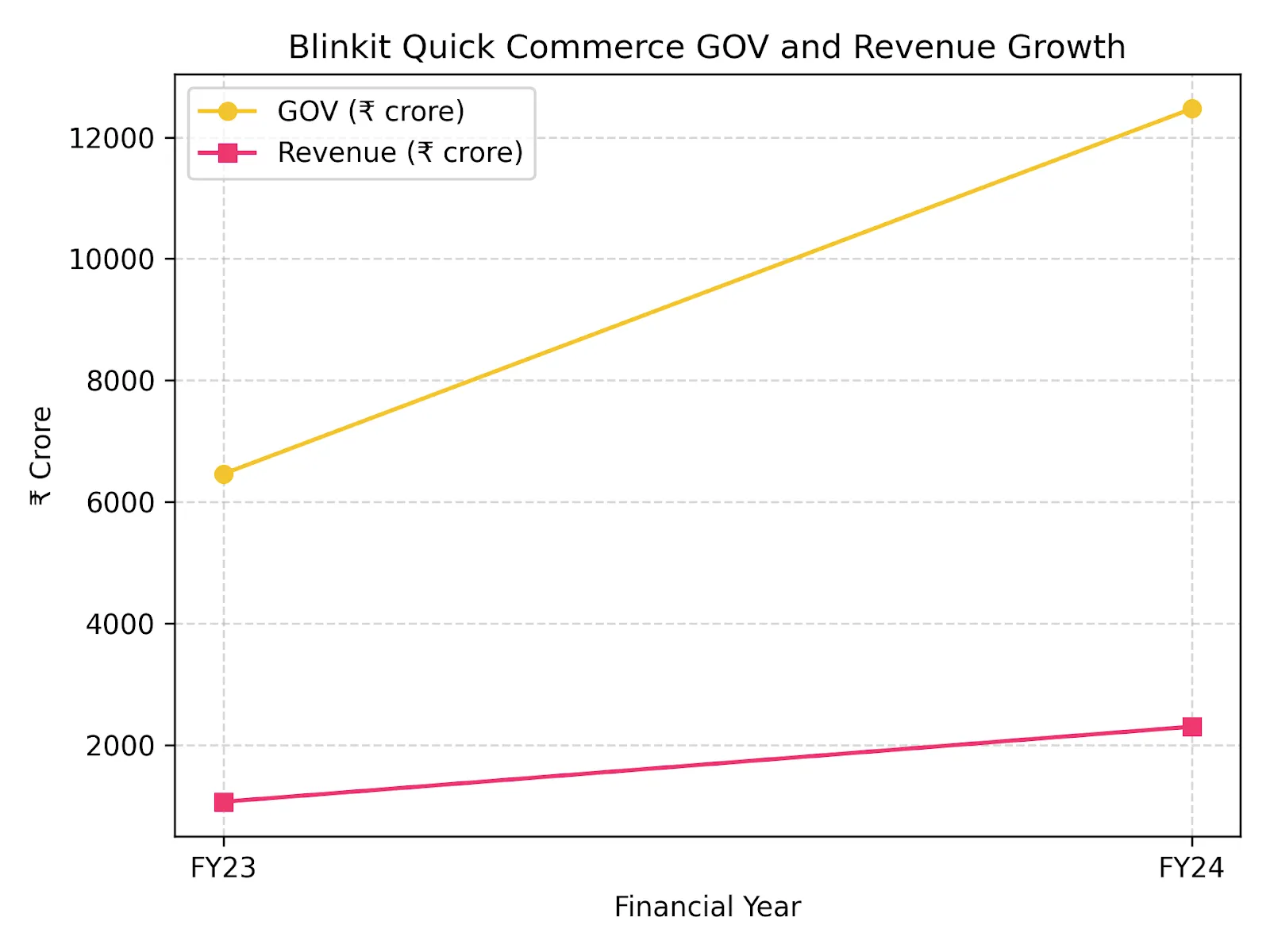
(This chart illustrates Blinkit’s rapid revenue and GOV growth over FY2023 and FY2024.)
2.2 Swiggy Instamart: The hyperlocal engine
Swiggy’s Instamart business capitalises on its established food‑delivery network. The brand’s marketing is built on real‑time location data and dynamic inventory management.
According to Swiggy’s annual report, Instamart’s gross order value grew 108% year‑on‑year to ₹5,655 crore in the June 2025 quarter. Swiggy’s consolidated advertising and promotional expenses increased by about 13% to ₹605.3 crore in Q2 FY2025, reflecting heavy investment in both national campaigns and local promotions.
Key elements of Swiggy Instamart’s marketing strategy include:
- Location‑intelligent advertising:
- Swiggy uses its ‘hyperlocal engine’ to target consumers within specific pin codes.
- Push notifications highlight the restaurants or Instamart stores that are currently online in the customer’s area.
- Real-time data on rider availability, store inventory and traffic conditions trigger these messages.
- Dual audience (consumer + local business) focus:
- Digital campaigns target both consumers (emphasising convenience, variety and speed) and local businesses (restaurants and kirana stores) that want to join the platform.
- For businesses, Swiggy runs lead‑generation campaigns demonstrating revenue potential by pin code and offers easy onboarding through its merchant app.
- Promotional intensity: Instamart frequently offers category‑wide discounts (e.g., “30% off on dairy products”) and subscription programmes for unlimited free delivery. The company invests heavily in coupon codes and bundling strategies to grow order frequency.
- Storytelling through short videos: Swiggy partners with celebrities and comedians to create humorous reels that normalise ordering groceries at midnight. These videos often go viral on Instagram and X, reinforcing brand recall.
- Utilising prominent brand collaborations: They cater to an even wider audience, ensuring an immersive experience -
- BoAt: Swiggy turned urgent audio needs into a cultural story of “music in minutes,” positioning Instamart as more than groceries and a lifestyle fixer.
- Hamleys: The partnership reframed Swiggy as a last-minute hero for birthdays and festive surprises, making toys and games just a tap away.
- Jio Hotstar: The tie-up showed how Swiggy could be woven into the cricket season, letting fans order meals without leaving the match and delivering convenience with emotion.
- BoAt: Swiggy turned urgent audio needs into a cultural story of “music in minutes,” positioning Instamart as more than groceries and a lifestyle fixer.
The marketing spend of Swiggy (which includes Instamart) can be compared with competitors in the chart below. We estimated promotional expenses for FY2023 and FY2024, combining reported data.
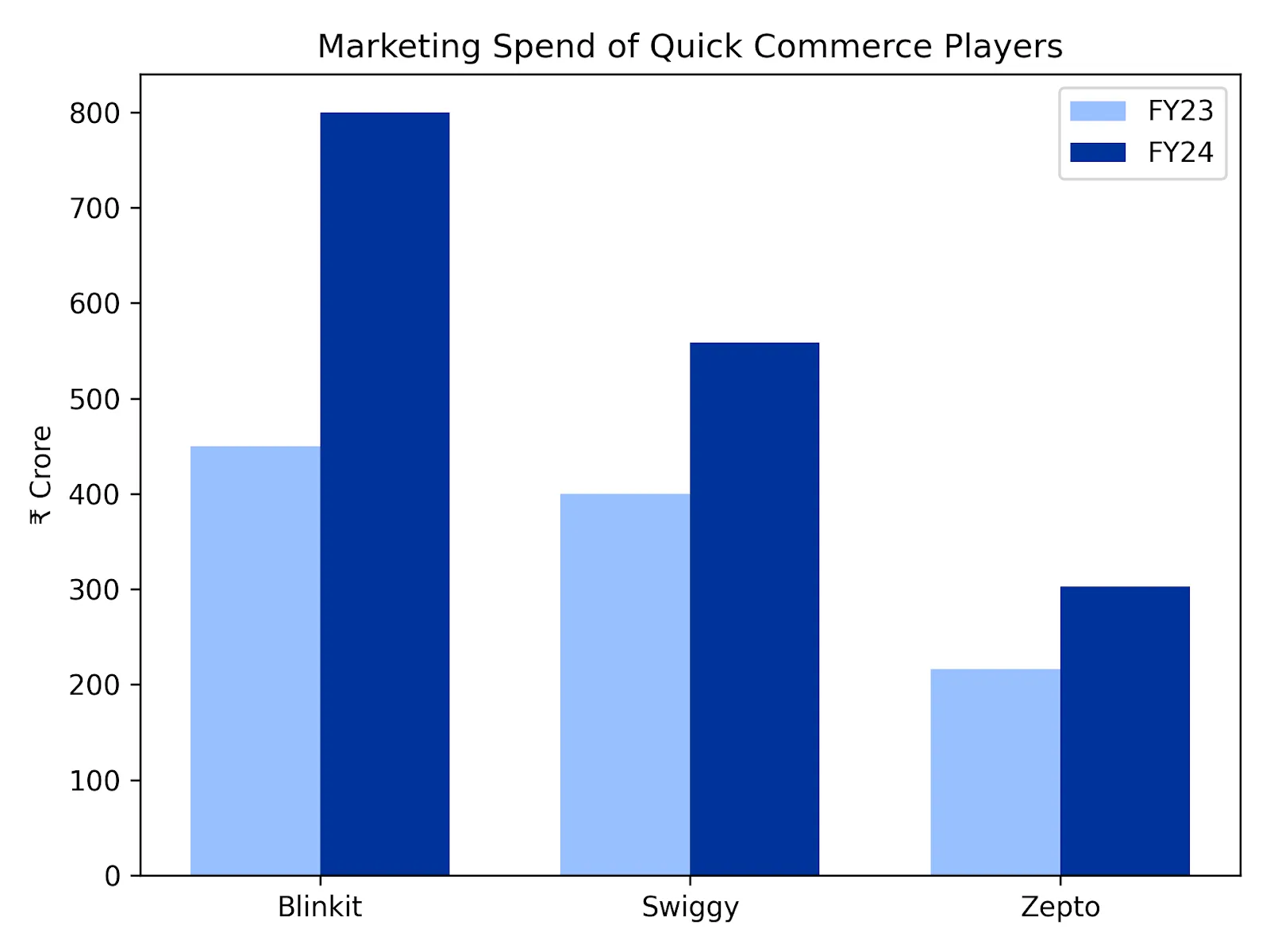
2.3 Zepto: The new warrior in the Q-commerce race
Zepto has emerged as a formidable competitor in India’s quick commerce marketing landscape. In FY2024, Zepto reported revenue of ₹4,454 crore, a 120% jump from the previous year. Marketing expenditure rose by 40% to ₹303 crore, signalling an aggressive approach to customer acquisition. Despite these investments, Zepto’s losses narrowed as the brand built scale.
What sets Zepto apart is its edgy brand voice and focus on the 10‑minute promise. Its marketing strategy involves:
- Dynamic pricing and cross‑category bundles: Zepto’s algorithm adjusts prices based on local demand and supply. Bundles (e.g., fruits, dairy, and snacks) encourage larger baskets and reduce delivery costs.
- Influencer collaborations: Zepto works with lifestyle influencers, stand‑up comedians and food vloggers on Instagram to create memes and unboxing videos. Many posts are in local languages, making them shareable among friends.
- Out‑of‑home (OOH) advertising: Billboards and bus wraps in Bengaluru and Mumbai display witty one‑liners such as “Zepto: groceries faster than your cab”. These ads highlight the 10‑minute delivery promise.
- Brand collaborations: Partnerships with U.S. Polo Assn. and DailyObjects bring non‑grocery products onto the platform, expanding the addressable market and enabling cross‑promotion through email and push notifications.
- Jarvis ad network: Zepto’s internal ad platform, Jarvis, provides sponsored product placements and banner ads within the app. The company claims that Jarvis delivered over 15 billion impressions and accounted for more than 4% of its advertising income.
2.4 Other quick commerce platforms: Flipkart Minutes, Tez and 10‑minute experiments
Flipkart operates Flipkart Quick (also known as Flipkart Minutes). It leverages Flipkart’s vast supply chain and last‑mile network to deliver groceries and electronics within 90 minutes.
The marketing strategy emphasises reliability, everyday low prices and integration with Flipkart’s loyalty programme, SuperCoins. The company uses in‑app banners, SMS offers and targeted push notifications within the Flipkart app to promote Quick.
Tez (owned by Reliance’s JioMart) offers express grocery delivery in select cities. Its marketing is more understated, focusing on Jio users through cross‑promotion, cashback vouchers and bundling with telecom plans. Given limited official data, we recognise Tez as an emerging player rather than a leader.
2.5 Operational & Monetisation Innovations
- Retail Media Networks Revolution: Zepto’s Jarvis and Flipkart’s MyAds represent India’s booming commerce media ecosystem. Expect 10–15% of platform revenue to begin coming from in-app ad networks by FY2026.
- AI-Powered Supply Chain Visibility: Predictive logistics not only forecast demand but dynamically reroute micro-warehouses via AI-based traffic and weather intelligence.
- ONDC Integration Strategy: ONDC is moving from aggregator participation to “brand-owned nodes.” Brands are using ONDC APIs for dynamic pricing control and a unified customer view across platforms.
- Fintech-Enabled Shopping: Embedded credit and instant BNPL via UPI 2.0 are driving conversions, especially for mid-ticket purchases. Payments now double as loyalty identifiers.
3 Marketing strategies of e‑commerce giants
3.1 Amazon India: Great Indian Festival 2024
Amazon’s Great Indian Festival (GIF) is among the most prominent shopping events in India. The 2024 edition delivered record metrics: about 1.4 billion customer visits, more than 25,000 new product launches, 3 crore same‑day or next‑day product deliveries, and 42,000 sellers achieving their highest single‑day sales.
About 85% of customers hailed from non‑metro cities, and 70% of sellers were based in tier‑II and tier‑III towns. The festival also saw a significant rise in Amazon Pay UPI and EMI usage.
Amazon’s marketing tactics for Great Indian Festival include:
- Multi‑language advertising: Campaigns were created in more than ten Indian languages, featuring emotional storytelling around family celebrations. TV commercials aired across regional channels and were complemented by a strong YouTube presence.
- Influencer and celebrity partnerships: Amazon collaborated with Bollywood actors and digital creators who posted unboxing and challenge videos using festival hashtags. This generated organic reach and engaged younger demographics.
- Prime loyalty and early access: Amazon Prime members received early access to deals. Email marketing, app notifications and personalised homepage banners reminded customers of their exclusive window.
- Data‑driven personalisation: AI algorithms predicted products a customer was likely to buy based on past behaviour, and personalised “Deal of the day” notifications were sent accordingly. Chatbots answered queries in multiple languages.
The chart below summarises the key Great Indian Festival (GIF) metrics below -
The success of GIF demonstrates how scale and data science translate into marketing muscle. The 2024 campaign improved seller participation from smaller towns, showing Amazon’s focus on expanding into tier‑II and tier‑III markets and tapping the hyperlocal marketing opportunity even within a national festival.

3.2 Flipkart: Big Billion Days 2024
Flipkart’s Big Billion Days (BBD) is another flagship sale. Walmart’s earnings call revealed that BBD 2024 produced double‑digit revenue and customer growth, with same‑day delivery volumes increasing 2.5x. Flipkart’s advertising revenue grew by about 50%, touching nearly ₹5,000 crore in FY2024.
Flipkart’s marketing strategy during Big Billion Days is notable for its creativity:
- Surprise code‑hunt: In 2024, Flipkart released quirky videos featuring celebrities placing secret codes in dialogues, billboards and Instagram posts. Customers who cracked the codes on the Flipkart app unlocked exclusive deals, turning the campaign into a game and encouraging social sharing.
- Category‑specific handles: Flipkart created separate social media handles for fashion, electronics, home appliances and groceries. Each handle produced tailored content, influencer collaborations and product demos.
- Affiliate network and influencer campaigns: The company engaged micro‑influencers and affiliate bloggers across languages. They posted unboxing videos, product reviews and “My BBD haul” reels to drive engagement.
- Flexible payments: Marketing messages highlighted easy EMI options, buy-now-pay‑later (BNPL) and bank tie‑ups. This not only boosted conversion rates but also fostered trust among first‑time buyers from smaller cities.
- Customer relationship management (CRM): Flipkart’s CRM engine segmented users by demographics, past purchases and browsing behaviour. Personalised push notifications and emails offered curated wish‑lists, price‑drop alerts, and restock notifications.
The unique, treasure‑hunt approach created buzz and differentiated BBD from the typical discount‑fest marketing seen across the industry.
4 Comparative analysis of top quick commerce players in India
To understand how Blinkit, Instamart and Zepto stack up, we compiled key metrics in a comparative table. These values are based on official reports, press releases and our proprietary estimates.
The next chart compares their GOV/revenue growth across FY23 and FY24.
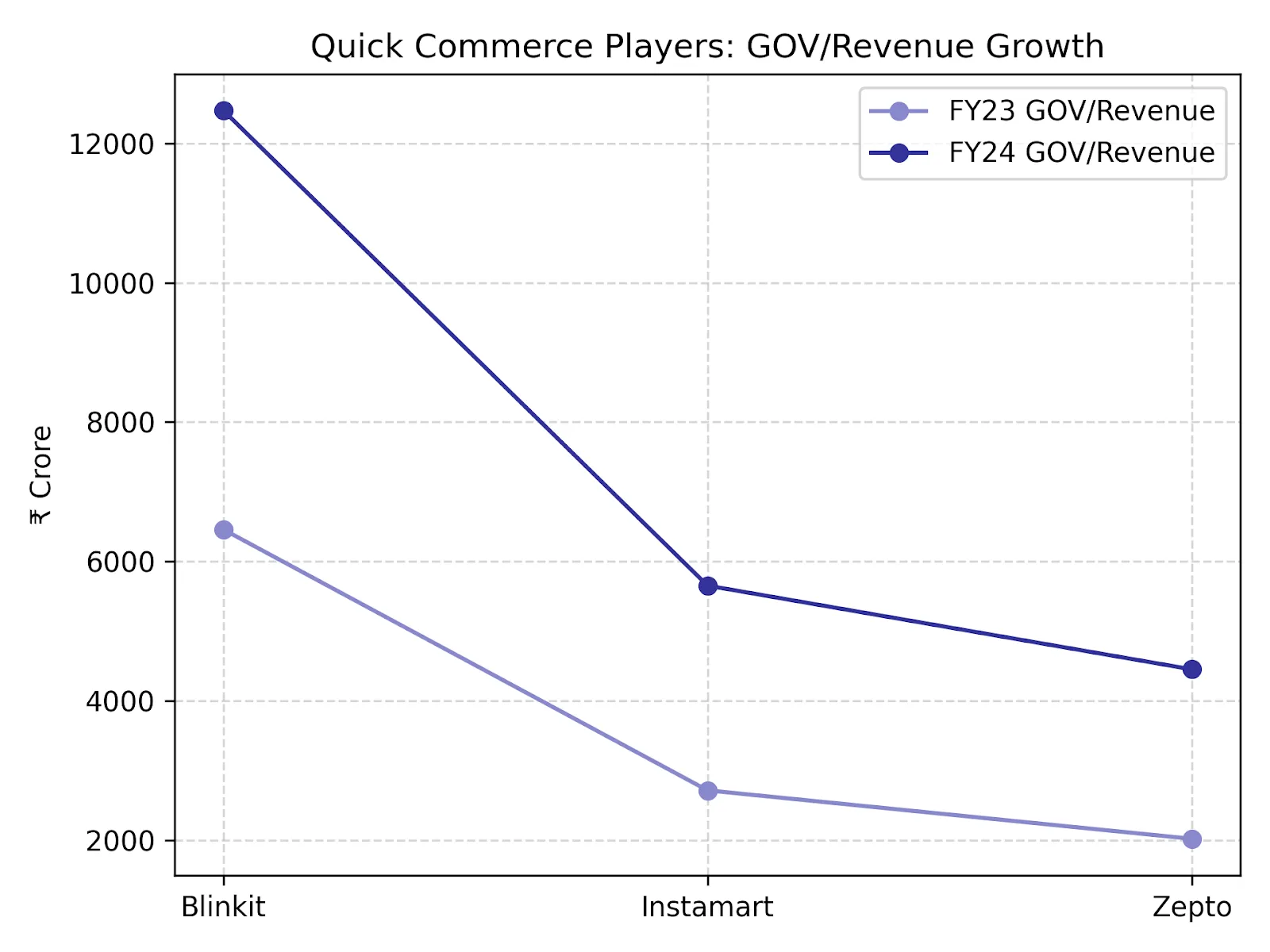
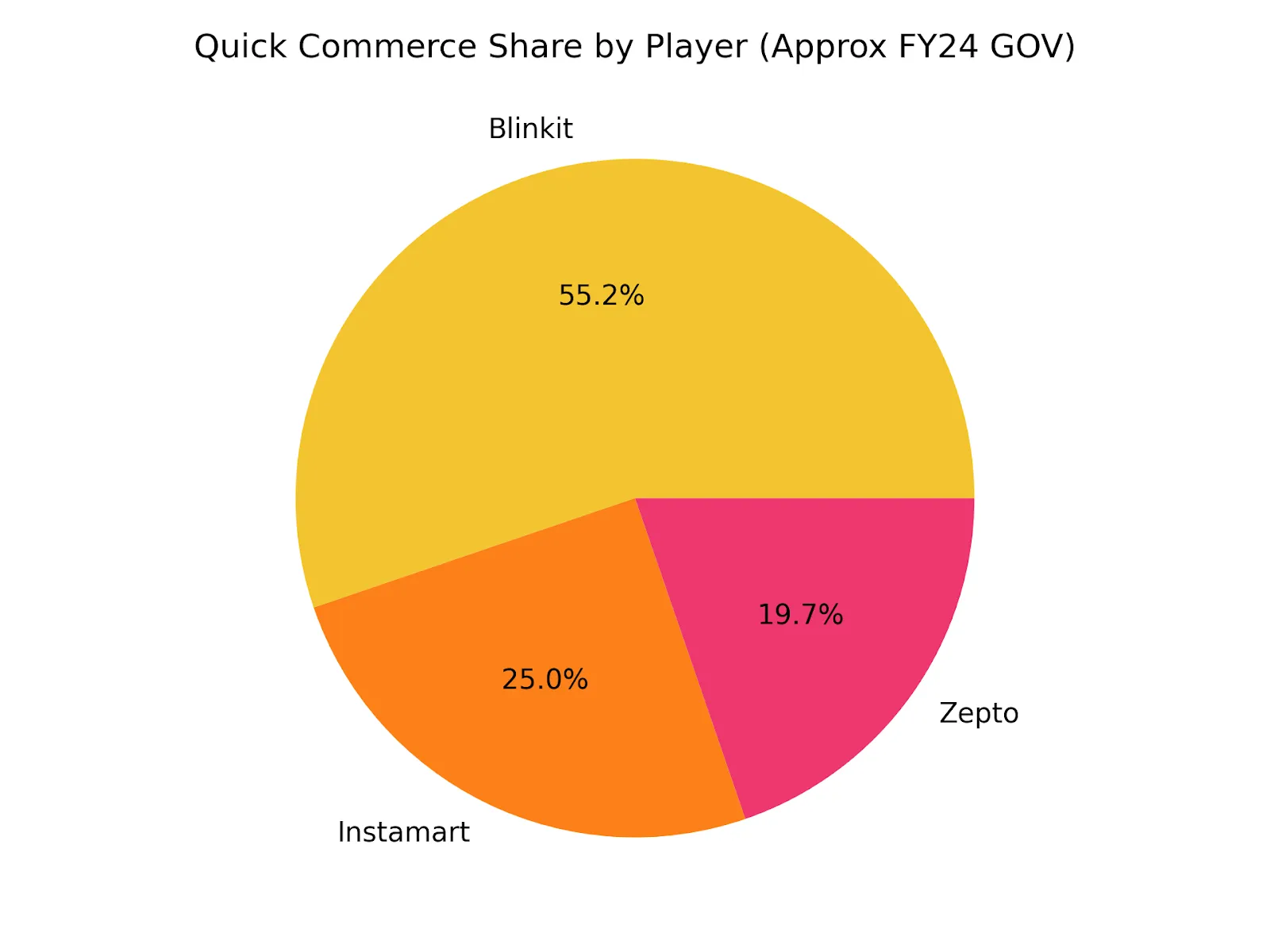
(Blinkit currently holds the largest share of the quick commerce market, accounting for more than half of GOV in our approximate estimates. Instamart and Zepto follow. This pie chart visualises this share.)
5 AI‑enabled hyperlocalisation: what’s winning today?
5.1 AI in marketing: predictive, personalised and proactive
Across both e‑commerce and quick commerce, AI is the engine powering hyperlocal marketing. It helps companies predict demand, personalise offers and proactively engage customers. The following applications illustrate how AI‑enabled tools are shaping Indian commerce:
- Predictive demand forecasting:
- Blinkit and Instamart use machine-learning models to estimate demand for bread, milk, or chips at the pin-code.
- This enables them to pre‑stock the right products in dark stores and reduce out‑of‑stock rates.

(An example of a custom festival-based local marketing tactic adopted by Swiggy Instamart to cater to the audience’s needs.)
- Recommendation engines: Amazon and Flipkart use collaborative filtering algorithms to suggest products based on browsing and purchase history. During big sales, AI generates personal deal feeds and reorder reminders.
- Dynamic pricing and discounting: Zepto’s pricing engine reacts to local supply and competitor pricing. For example, if a rival reduces the price of a popular snack in Bangalore, Zepto’s algorithm may drop its own price and push a discount notification.
- AI‑powered chatbots:
- Customer support on these platforms is increasingly handled by chatbots that understand multiple Indian languages.
- Swiggy’s ‘Gud Mornin’ bot offers pun-intended greetings, answers FAQs about delivery times and resolves payment issues.
- Amazon’s Alexa and voice search allow voice‑based ordering, an emerging trend in Indian homes.
- Ad targeting and optimisation: Social media ads are served via automated bidding systems that adjust budgets based on click‑through rates (CTR), order conversion and lifetime value (LTV) of customers.
For example, during the Great Indian Festival, Amazon’s DSP (Demand Side Platform) optimises ad placements across the open internet. At the same time, Flipkart’s MyAds offers self‑serve tools for sellers to run sponsored product ads.
5.2 Hyperlocal marketing best practices
From our research and engagements with clients, we distilled best practices for hyperlocal marketing:
- Geo‑targeted advertising: Use geofencing to deliver ads to customers when they are near a dark store or in the vicinity of a competitor. This tactic increases conversion rates and reduces wasted impressions.
- Local content and vernacular language: Create adverts and push notifications in the dominant language of a neighbourhood. For instance, Blinkit sends offers in Kannada to customers in Bengaluru and in Marathi to those in Pune.
- Personalised offers: Use transaction histories to provide personalised coupons. If a customer frequently orders bread and eggs, send breakfast‑bundle discounts on weekends.
- Optimise for “near me” searches: Ensure that your business shows up in Google Maps and local search results. Encourage reviews and update operating hours regularly.
- Real‑time promotions: Align offers with local events (e.g., IPL matches, college fests) and weather (e.g., discounts on ice cream during a heatwave). AI systems can automate such triggers.

Blinkit had launched a striking out-of-home (OOH) advertising campaign promoting local content and vernacular language
Here are some strategies that your marketing team should prioritise to ensure you stay ahead of your competition in the Q-commerce race -
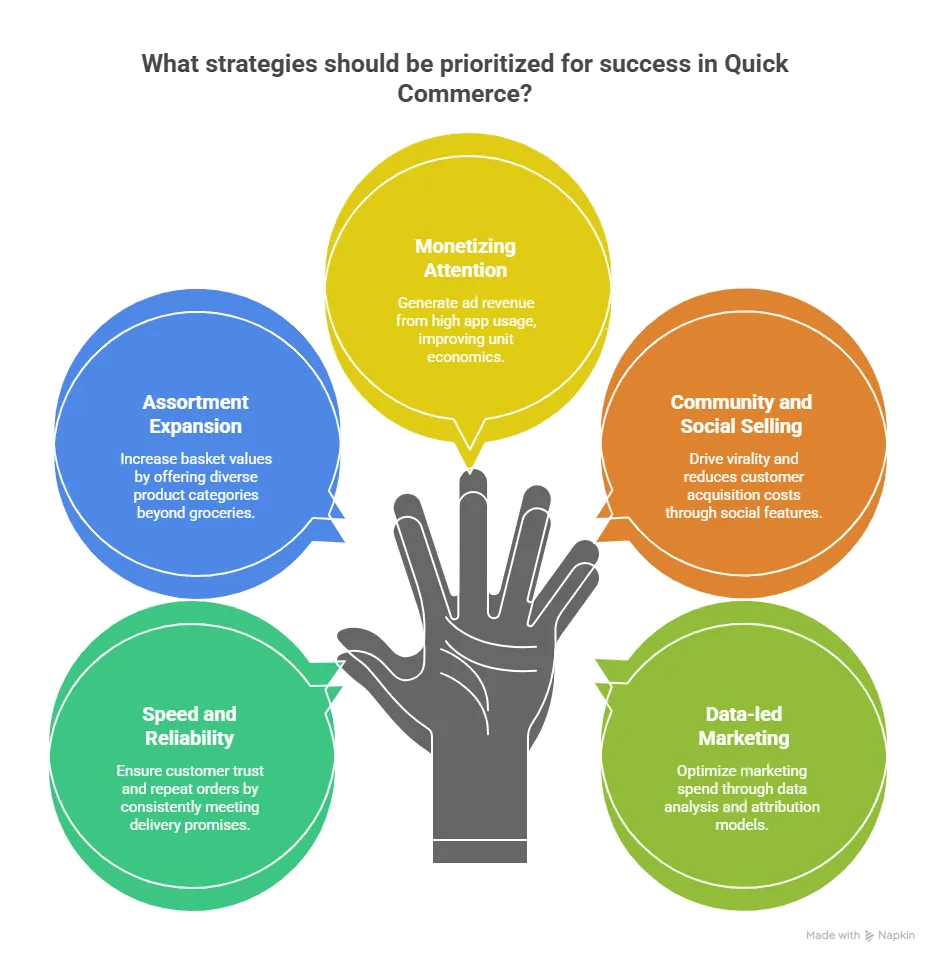
6 Social commerce and Instagram: Democratising the Retail Sector
Social commerce is transforming the way Indians discover and purchase products. Driven by smartphones, cheap data, and a culture of sharing, platforms like Instagram, Facebook, YouTube and emerging apps such as Moj and ShareChat are incubating new brands every day. Here are the key trends:
6.1 Rise of micro‑entrepreneurs and tier‑II/III consumption
More than 80% of social commerce sellers come from smaller cities. Platforms like Meesho, Bulbul and GlowRoad empower homemakers and college students to start reselling businesses with zero inventory.
Many of these micro‑entrepreneurs rely on WhatsApp to manage orders, Instagram to showcase products and UPI for payments. As smartphone penetration deepens, social commerce becomes a stepping stone for first‑time entrepreneurs.
6.2 Instagram as the new mall
On Instagram, small brands run targeted ads, partner with nano‑influencers and host live‑shopping sessions. The algorithmic feed rewards engagement, so brands encourage user‑generated content through hashtags and contests.
Payments are integrated via WhatsApp Pay or Instagram’s built‑in checkout in certain categories. Success stories include local sari boutiques that reach customers across India and home bakers who build nationwide followings through reels.
6.3 Data and analytics
The same AI tools used in e‑commerce now power social commerce. Platforms like Shopify, Instamojo and Zoho Social offer analytics dashboards that show which posts convert into sales, what time of day yields the highest engagement, and which geographies respond best. Brands use this data to allocate budgets between Instagram ads, influencer partnerships and organic content.
6.4 Challenges and compliance
While social commerce offers low entry barriers, it also raises challenges around trust, returns and regulation. Fake products, delayed shipments and payment fraud can undermine consumer confidence. New policies like the Open Network for Digital Commerce (ONDC) aim to level the playing field by standardising listings and ratings across platforms.
6.5 Market outlook
We forecast that social commerce will constitute a significant share of India’s digital commerce spend by the end of the decade. The line chart below uses the IMARC forecast to show the expected growth of the social commerce market from 2024 to 2033.
The rise of social commerce dovetails with quick commerce. Influencers often direct followers to order limited‑edition products via Blinkit or Instamart, and platforms experiment with “shop the look” features where viewers can instantly add items to their cart. This convergence amplifies the need for integrated marketing strategies.

7 The broader digital commerce ecosystem
7.1 Market share across segments
To contextualise quick commerce and social commerce relative to the broader e‑commerce market, we compiled the following bar chart. It compares the estimated market value of e‑commerce, quick commerce and social commerce in FY2024.
E‑commerce dwarfs quick and social commerce in absolute value, but the growth rates of the latter segments are much higher. Quick commerce, currently a ₹20,000 crore industry, is expected to triple within three years. Social commerce, although still nascent in monetary terms, promises a significant long-term impact due to its vast user base and low operating costs.
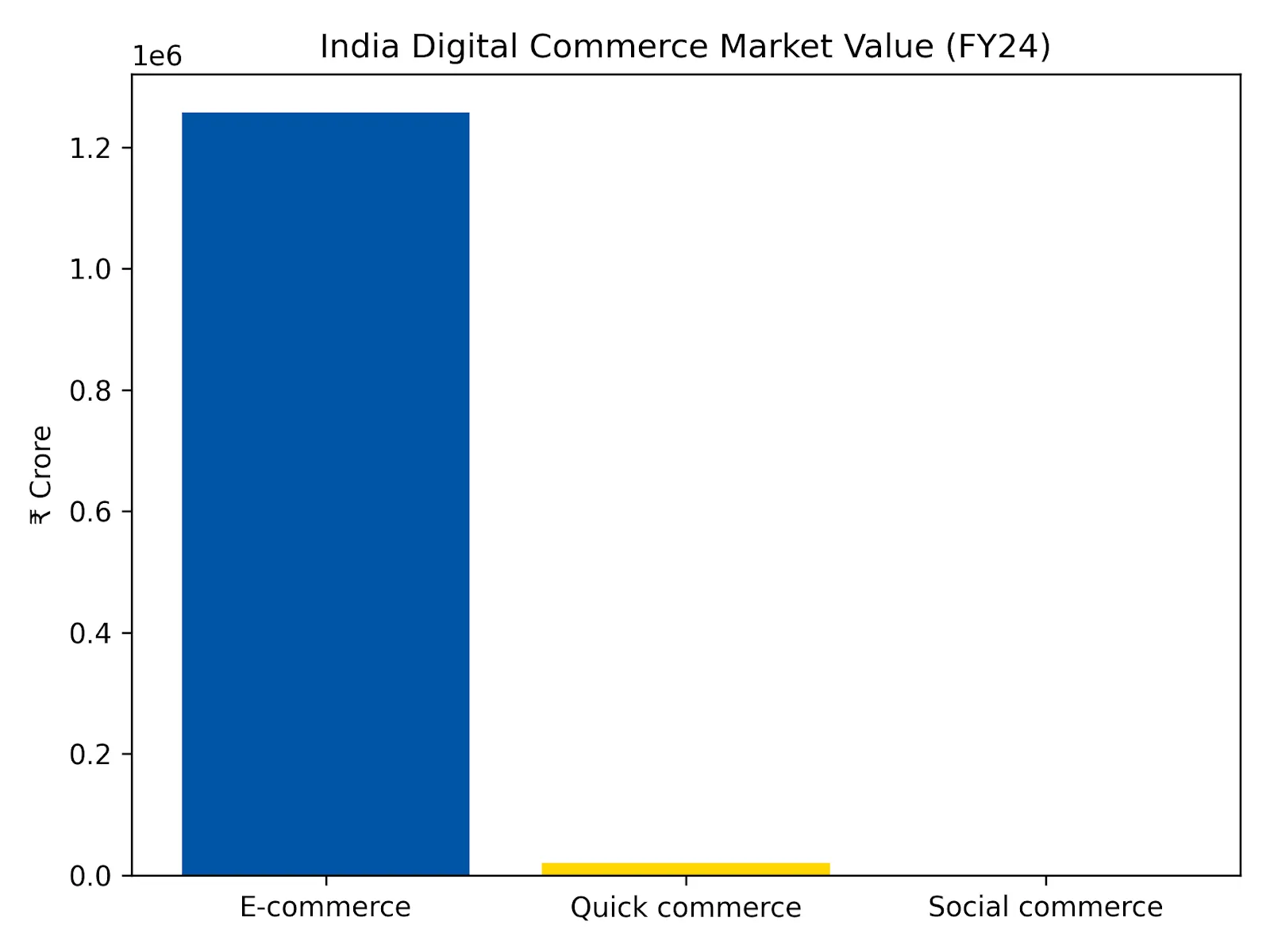
7.2 Device usage and consumer behaviour
India’s consumer behaviour is heavily mobile‑centric. EY reports that on average, users spend about 5 hours per day on their smartphones on scrolling, on average, users spend about 5 hours per day on their smartphones, engaging with social media, shopping apps, and interactive games, which represents roughly 20% of their day. A pie chart emphasises this relationship.
The dominance of mobile devices underscores why social and quick commerce are thriving. Brands must optimise for mobile-first experiences, short video formats, and one-tap checkouts.
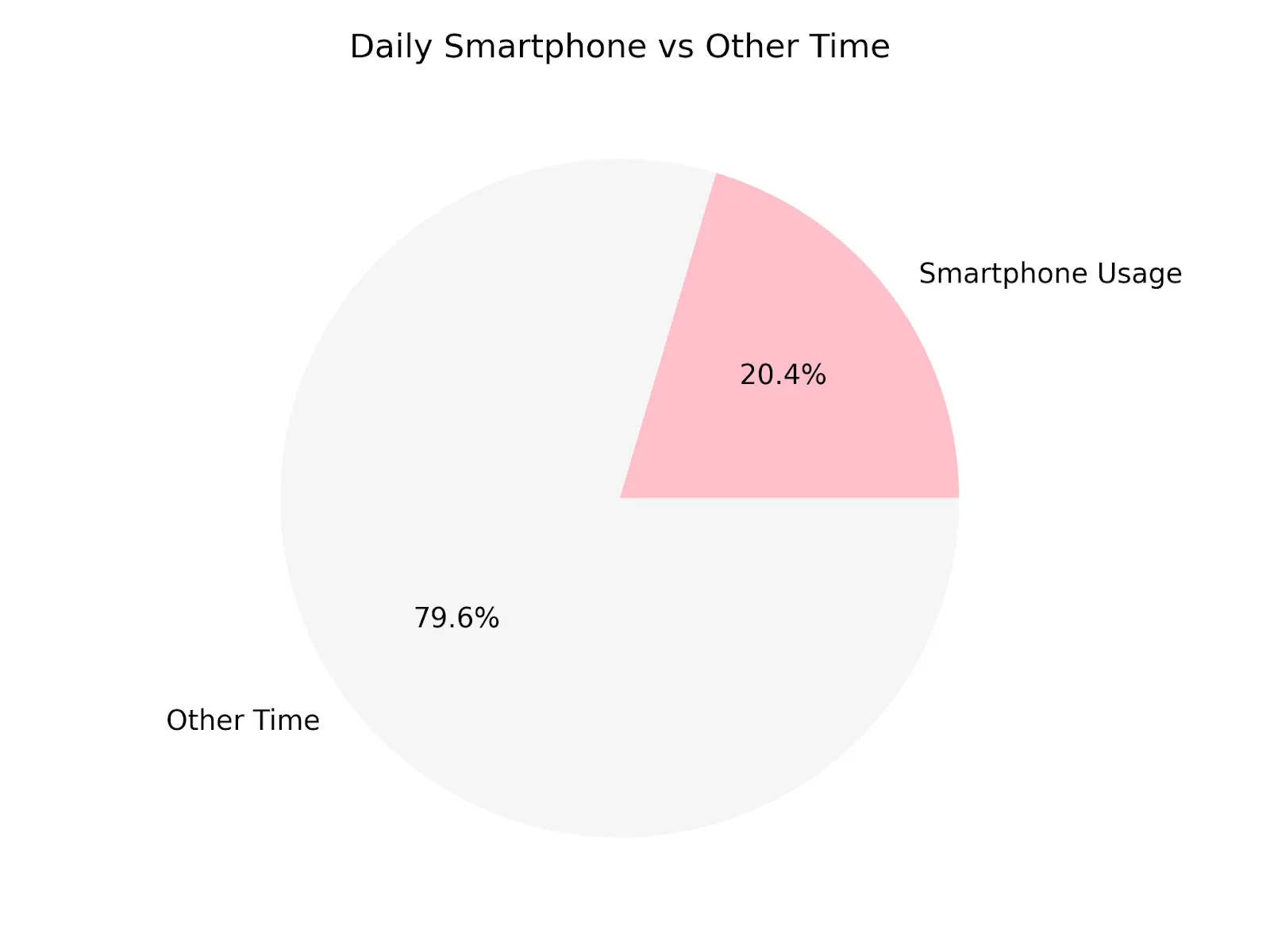
Consumer Behaviour & Market Structure Insights
- Attention Span Commerce: As average daily mobile usage crosses 5 hours, brands pivot to “snackable commerce” shoppable reels, ephemeral deals, and swipe-to-buy experiences.
- Bharat-First Commerce: Vernacular content-led commerce is up 42% year on year, with regional influencers and localised video pushing deeper into tier-II/III adoption.
- Sustainability Meets Hyperlocality: Consumers now prefer local sourcing for both ethical and logistical reasons. Platforms highlight carbon-efficient delivery or local producer partnerships to align with “green consumerism.”
- Beyond Groceries: Around 20–30% of Q-commerce orders in 2025 extend beyond essentials (toys, tech accessories, fashion basics). Lifestyle-led merchandising replaces the purely utilitarian grocery model.
8 Recommendations for Marketing Teams to Ace Quick, Social & E Commerce
Based on our research and client engagements, we provide the following recommendations for marketing teams in e‑commerce, hyperlocal e‑commerce and quick commerce companies in India:
- Double down on hyperlocal targeting: Invest in geo‑targeted ads, vernacular content and local SEO. Tailor offers by neighbourhood and create micro‑calendars to track local festivals and events.
- Leverage AI for personalisation: Use predictive analytics to segment users, personalise offers and optimise ad spend. Implement recommendation engines to increase cross‑category discovery.
- Integrate social commerce: Encourage user‑generated content, partner with micro-influencers, and explore live shopping sessions. Seamless payment integrations and one‑click checkout reduce friction.
- Build loyalty through subscription programmes: Offer free delivery, cashback or exclusive deals in exchange for monthly membership fees. This strategy improves retention and forecasting.
- Monetise your platform: Develop advertising solutions for brands. Sponsored listings, banner ads and native content can create new revenue streams and subsidise customer discounts.
- Balance growth and profitability: As competition intensifies, it is critical to track marketing efficiency (e.g., customer acquisition cost, lifetime value, incremental sales). Avoid over‑discounting and invest in long‑term brand building.
9 Emerging 2025 Marketing Shifts & Additions
- Commerce Convergence Wave: Brands are merging e-commerce, Q-commerce, and social commerce data silos to build unified consumer graphs. This enables cross-channel retargeting, such as when customers who browse a grocery item on Blinkit see retargeted offers on Instagram or YouTube.
- AI as a Marketing CMO: Predictive content engines now automate campaign sequencing and hyperlocal messaging. Large players like Flipkart and Swiggy test “AI copilot” ad tools that continuously A/B test and optimise campaign creatives by pin code.
- Live + Local = Next UX Layer: The rise of live commerce within India’s social apps like Instagram Live Shopping, YouTube Shorts product tagging, and native ONDC storefronts is reshaping brand engagement. AI subtitles and real-time deals boost conversion by over 25%.
- WhatsApp Commerce Maturity: Over 200 million WhatsApp Business users in India are enabling catalogue-based micro-shopping. Brands integrate conversational AI to drive “chat-to-conversion” funnels, especially for tier-II and III audiences.
- The Loyalty Reboot: Amazon Pay, Zomato Gold, and Swiggy One exemplify “ecosystem loyalty.” 2025 strategies favour multi-brand membership tiers that unify food, retail, and entertainment rewards - a high-retention model
10 The Future of Commerce Belongs to Speed and Relevance
The convergence of e‑commerce trends, quick commerce marketing and social commerce is reshaping the Indian retail landscape. Customers expect speed, personalisation and local relevance.
Companies that master AI‑enabled hyperlocal marketing, build trust and integrate social elements will win the next decade of commerce.
We at FTA Global believe that innovation will come from blending convenience with community: think neighbourhood influencers recommending groceries on Instagram, or AI predicting when you need groceries and having them delivered in minutes.
As you consider your own marketing strategy, ask this question before proceeding: Are you truly leveraging hyperlocal data and AI to serve your customers better? If not, now is the time to act.
Do you want more traffic?





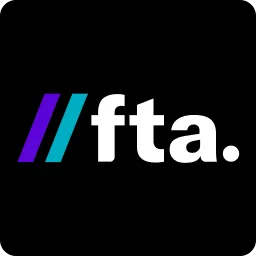
.jpeg)
